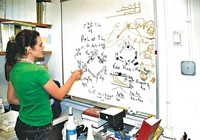Advertisement
Grab your lab coat. Let's get started
Welcome!
Welcome!
Create an account below to get 6 C&EN articles per month, receive newsletters and more - all free.
It seems this is your first time logging in online. Please enter the following information to continue.
As an ACS member you automatically get access to this site. All we need is few more details to create your reading experience.
Not you? Sign in with a different account.
Not you? Sign in with a different account.
ERROR 1
ERROR 1
ERROR 2
ERROR 2
ERROR 2
ERROR 2
ERROR 2
Password and Confirm password must match.
If you have an ACS member number, please enter it here so we can link this account to your membership. (optional)
ERROR 2
ACS values your privacy. By submitting your information, you are gaining access to C&EN and subscribing to our weekly newsletter. We use the information you provide to make your reading experience better, and we will never sell your data to third party members.
Synthesis
Newscripts
Adventures Of Bax: Science Tattoos
by Linda Wang and Stu Borman
August 27, 2007
| A version of this story appeared in
Volume 85, Issue 35
Adventures of Bax
Bax, an acronym for B-cell lymphoma 2-associated X protein, is a human protein that promotes apoptosis. But Bax is also the last name of a noted human—senior investigator Ad Bax of the Laboratory of Chemical Physics at the National Institute of Diabetes & Digestive & Kidney Diseases, a specialist in nuclear magnetic resonance (NMR) methods for the study of macromolecular structure and dynamics.
Researchers made an important discovery about Bax (the protein) in July. Xu Luo and coworkers at the Eppley Institute for Research in Cancer & Allied Diseases of the University of Nebraska Medical Center, Omaha, report in Genes & Development (2007, 21, 1937) that they mapped the active site of Bax responsible for the protein's apoptotic activity.
The news reminded Ad Bax that nearly a decade ago, he thought it would be a significant scientific breakthrough, and also amusing, if the Bax group could be first to determine the three-dimensional NMR solution structure of Bax.
Alas, this was not to be. "My former postdoc, Nico Tjandra, scooped me in determining the first structure of this protein," said Bax in an e-mail message, complete with a sad-faced emoticon.
National Institutes of Health researchers Motoshi Suzuki, Richard J. Youle, and Tjandra snatched the Bax structure (shown, upper right) from the jaws of Bax's victory seven years ago (Cell 2000, 103, 645). Rumor has it that since then, Bax has been hoping for the discovery of a protein called Nico.
Science Tattoos

Science writer Carl Zimmer has stumbled upon a "hidden iceberg" in the scientific community: Scientists wear tattoos. And not just any old tattoos, but tattoos that proudly proclaim their work.
Zimmer began to draw this conclusion after noticing that his friend Bob Datta, a postdoc at Columbia University, sports a tattoo of DNA on his shoulder. Zimmer then began a discussion on his blog, "The Loom" (http://scienceblogs.com/loom), to find out how many other researchers also brand themselves with science.
Minutes after posting the question on Aug. 6, Zimmer began receiving photos of people's tattoos. One blogger shared a tattoo of the DNA double helix wrapped around her ankle, and another person revealed that she has the structure of ATP permanently etched onto her torso. Still another commenter shared a photograph of a "DNA dragon" that watches his back. And one man went so far as to tattoo the entire periodic table onto his forearm. (Was he trying to cheat on an exam?)
Zimmer has realized that many tattoos are very personal. In fact, Datta's tattoo represents, in genetic code, his wife's initials: EEE. "Geek love in the noblest form," jests Zimmer.
The tattoos apparently cross all disciplines of science. Zimmer recalls one mycologist he met whose arms were covered with a black mesh, apparently a subterranean network of threads produced by the death cap mushroom. And he's met a developmental biologist whose arm is swathed in the image of the fish he studies.
To date, Zimmer has received more than 100 comments on this topic. "The stream of tattoo pictures coming into my inbox is causing me to freak out, ever so slightly," Zimmer writes on his blog. "I didn't quite bank on this site becoming a clearinghouse for science tattoos."
Nevertheless, he invites others to e-mail him photos of their science tattoos at blog@carlzimmer.com and says he'll post them on his blog. "If you're worried about tenure, just let me know how the tattoo represents the object of your study," Zimmer reassures.
This week's column was written by Linda Wang and Stu Borman. Please send comments and suggestions to newscripts@acs.org.





Join the conversation
Contact the reporter
Submit a Letter to the Editor for publication
Engage with us on Twitter